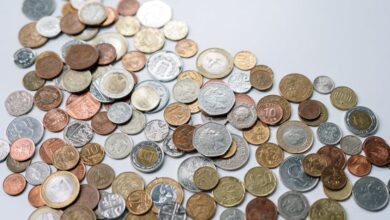Unlocking Value: The Economic Impact of Metal Recycling on Precious and Industrial Metals in Today’s Market

The world of metal recycling is not just an environmental necessity; it's an economic powerhouse that significantly impacts markets globally. As we navigate through the complexities of metal commodities, understanding the financial implications of this industry becomes essential. Metal recycling serves as a critical component in the circular economy, providing value not only through the recovery of precious metals like gold and silver but also through the recycling of industrial metals such as steel, aluminum, and copper.
In this article, we will delve into the economic value of recycled metals, exploring how ferrous and non-ferrous metals contribute to sustainable metal production. We will also examine emerging trends in metal commodities, from the growing interest in gold and silver investing to the rising importance of battery metals like lithium and zinc in modern technology. Furthermore, we will look at the dynamics of metal fabrication and metallurgy that influence markets, especially in sectors such as construction, aerospace, and automotive. Join us as we uncover the multifaceted world of metal recycling, where economic value meets sustainable practices, and discover how this sector is shaping the future of metal mining and production.
- 1. Economic Impact of Metal Recycling: A Closer Look at Precious and Industrial Metals
- 2. The Role of Ferrous and Non-Ferrous Metals in Sustainable Metal Production
- 3. Emerging Trends in Metal Commodities: From Gold and Silver Investing to Battery Metals
1. Economic Impact of Metal Recycling: A Closer Look at Precious and Industrial Metals
The economic impact of metal recycling is significant, influencing various sectors and contributing to sustainable practices in today's market. Precious metals, such as gold, silver, platinum, and palladium, hold substantial value in both investment and industrial applications. Gold investing and silver investing have long been considered safe havens in times of economic uncertainty, which drives demand for recycled precious metals. The recycling of these metals not only reduces the need for metal mining but also mitigates the environmental impact associated with extracting primary resources.
On the other hand, the market for industrial metals, which includes ferrous metals like steel and non-ferrous metals such as aluminum, copper, zinc, and lithium, is equally crucial. These materials are essential in various industries, including construction, automotive, aerospace, and energy sectors. Sustainable metal production through recycling helps stabilize prices of metal commodities by providing a reliable supply that meets the increasing demand without further depleting natural resources.
Recycling also plays a pivotal role in the production of metal alloys and base metals, which are vital in manufacturing processes. For example, 3D printing metals have gained traction in industries due to their versatility and efficiency. Furthermore, the growing focus on battery metals, particularly lithium for electric vehicles, highlights the importance of recycling to ensure a sustainable supply chain.
The economic benefits of metal recycling extend beyond immediate financial gains. It fosters innovation in metallurgy and metal fabrication, leading to the development of new technologies that enhance the efficiency and durability of metal products. Additionally, the recycling process contributes to reducing metal corrosion, thus prolonging the lifespan of metal components in various applications.
Overall, the interplay between metal recycling and the economy is evident in the rising trends within the industry. As the demand for recycled metals continues to grow, it becomes increasingly clear that adopting sustainable practices in metal production and utilization is not just beneficial but essential for a robust economic future.
2. The Role of Ferrous and Non-Ferrous Metals in Sustainable Metal Production
The role of ferrous and non-ferrous metals is pivotal in the realm of sustainable metal production. Ferrous metals, which primarily include steel and iron, are vital for numerous applications, including construction, automotive manufacturing, and energy infrastructure. Their strength and durability make them essential materials in building frameworks, bridges, and vehicles. The recycling of ferrous metals not only reduces the need for metal mining but also significantly lowers energy consumption, as recycled steel requires approximately 60% less energy than producing new steel from raw materials.
On the other hand, non-ferrous metals such as aluminum, copper, zinc, and precious metals like gold and silver, play an equally important role in various industries. These metals are crucial for creating metal alloys that enhance performance and durability in products ranging from jewelry to aerospace components. For instance, aluminum is widely used in lightweight automotive designs, while copper is essential for electrical applications due to its excellent conductivity. Recycling non-ferrous metals can save up to 90% of the energy needed for primary production, making it an attractive option for manufacturers aiming for sustainability.
The intersection of metallurgy and sustainable practices is underscored by the growing demand for rare earth metals and battery metals, which are critical for advanced technologies such as electric vehicles and renewable energy systems. As global efforts intensify to combat climate change, the focus on metal recycling will likely shift towards these vital materials, ensuring a more sustainable approach to metal production.
Moreover, the emerging trends in 3D printing metals are revolutionizing how industries utilize ferrous and non-ferrous metals, allowing for reduced waste and enhanced efficiency in metal fabrication processes. By investing in the recycling of both ferrous and non-ferrous metals, industries can contribute to a circular economy that maximizes resource efficiency while minimizing environmental impact.
In conclusion, the economic value of recycled metals, whether ferrous or non-ferrous, is significant. The market impact of these recycled materials not only supports sustainable metal production but also fosters innovation across various sectors, including construction, automotive, and energy, leading to a more sustainable future.
3. Emerging Trends in Metal Commodities: From Gold and Silver Investing to Battery Metals
The landscape of metal commodities is constantly evolving, influenced by various economic factors, technological advancements, and shifts in consumer demand. Among the most notable emerging trends in metal commodities are the growing interest in precious metals such as gold and silver for investing, as well as the rising significance of battery metals in the context of sustainable energy solutions.
Gold investing and silver investing have historically been viewed as safe-haven assets during times of economic uncertainty. In recent years, their appeal has been amplified by geopolitical tensions and inflation concerns. Investors are increasingly turning to these precious metals not only for their intrinsic value but also as a hedge against market volatility. The market for jewelry metals remains robust, with demand for gold and silver jewelry continuing to thrive, particularly in emerging economies where a burgeoning middle class is driving consumption.
On the other end of the spectrum, industrial metals are witnessing a transformative shift due to the rapid growth of electric vehicles (EVs) and renewable energy technologies. Battery metals such as lithium, cobalt, and nickel are in high demand as manufacturers seek to produce more efficient and sustainable energy storage solutions. As the global push for sustainable metal production intensifies, these metals are becoming critical components in the drive towards a greener economy. This trend is further supported by advancements in metallurgy and metal fabrication, which enhance the performance and longevity of battery systems.
Additionally, the growing emphasis on recycling and the circular economy is reshaping the metal market. Metal recycling plays a crucial role in reducing waste and conserving natural resources, making it an essential practice for industries reliant on non-ferrous metals like aluminum and copper. The recycling of these metals not only lowers production costs but also lessens the environmental impact associated with metal mining, particularly for rare earth metals and base metals.
In construction and automotive sectors, the demand for lightweight yet durable materials continues to rise, prompting manufacturers to explore innovative solutions such as 3D printing metals. This technology allows for the creation of complex metal alloys that meet specific performance requirements while minimizing material waste. Steel and aluminum remain dominant in construction metals, while copper and zinc are pivotal in automotive applications.
Moreover, the market for aerospace metals is evolving, with an increasing focus on refractory metals and high-performance alloys that can withstand extreme conditions. The interplay between traditional metal mining and recycling is vital to meet the evolving needs of industries and ensure a sustainable supply chain.
As we move forward, it is clear that the dynamics of metal commodities will be significantly shaped by these emerging trends, paving the way for a future that balances economic viability with environmental responsibility. Understanding these trends is crucial for investors, policymakers, and industry leaders looking to navigate the complexities of the metal market.
In conclusion, the economics of metal recycling presents a compelling case for both environmental sustainability and financial opportunity. As we've explored, the economic impact of recycling varies significantly between precious metals and industrial metals, with each playing a crucial role in the overall market dynamics. The increasing demand for ferrous and non-ferrous metals is reshaping sustainable metal production practices, highlighting the importance of recycling in reducing the need for traditional metal mining.
Emerging trends in metal commodities, particularly in areas such as battery metals and precious metals like gold and silver investing, indicate a growing market interest that is likely to reshape the future of metallurgy. The rise of energy metals, including lithium and cobalt, reflects not only the technological advancements in sectors like automotive and aerospace but also the critical need for responsible sourcing and metal fabrication.
As industries continue to innovate with materials such as 3D printing metals and explore the potential of rare earth metals, the recycling of base metals like steel, aluminum, copper, and zinc will remain vital. This sustainable approach not only mitigates metal corrosion and waste but also enhances the value chain in construction and jewelry sectors, among others.
Ultimately, the intersection of economic viability and environmental responsibility through metal recycling is paving the way for a more sustainable future, making it a pivotal focus for investors and industries alike. By embracing these trends and understanding their implications, we can foster a more resilient and efficient metal economy.
References:
(Include your sources here)





